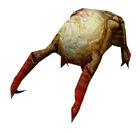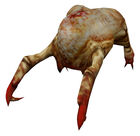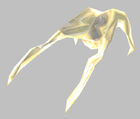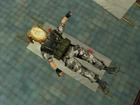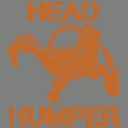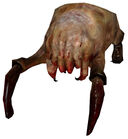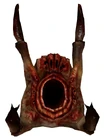Laogeodritt (talk | contribs) (→Behavior and skills: - rewrite first parag for style/flow) |
|||
| Line 31: | Line 31: | ||
==Behavior and skills== |
==Behavior and skills== |
||
| − | + | The headcrab can appear harmless at a glance: it is small and slow-moving with its tip toe-like gait. Although it can quickly leap long distances using its hind legs, tilting its body upwards to turn its mouth towards its target, such an assault can only inflict minor injuries with the claws, legs and teeth. However, the Headcrab's main goal is not to kill, but to attach itself onto an appropriate host's head. Using its leaping ability, it can reach a host's head and attempt to burrow its beak through the skull. Once successful, the Headcrab takes control of the host's nervous system and causes physical alterations to the host's body, such as causing its fingers grow into claws, via unknown biological processes. The host then rips open its own torso, revealing the stomach and other organs, for feeding purposes. Such a Headcrab-controlled host is called a [[Standard Zombie]] (distinct from zombies created by other [[Headcrab|Headcrab subspecies]], which have different characteristics). |
|
A Headcrab will frequently lie and wait in dark corners or ventilation shafts for unsuspecting prey to walk by. In more open environments, the creatures are known to bury themselves in the ground to hide, then climb out to the surface and attack when a possible host draws near. Headcrabs appear to be fairly unintelligent creatures and will pursue their prey under the most dangerous conditions, moving through dangerous areas or towards hostile prey, even as fellow Headcrabs die in front of them. |
A Headcrab will frequently lie and wait in dark corners or ventilation shafts for unsuspecting prey to walk by. In more open environments, the creatures are known to bury themselves in the ground to hide, then climb out to the surface and attack when a possible host draws near. Headcrabs appear to be fairly unintelligent creatures and will pursue their prey under the most dangerous conditions, moving through dangerous areas or towards hostile prey, even as fellow Headcrabs die in front of them. |
||
Revision as of 05:20, 29 December 2010
| You can help by correcting spelling and grammar, removing factual errors, rewriting sections to ensure they are clear and concise, and moving some elements when appropriate. Visit our Cleanup Project for more details and, please, notify the administrators before removing this template. |
Template:Image
| Although this article is based on official information, the actual name of this subject is pure conjecture. |
- "These crabs have a unique parasitic strategy don't you think."
- ―Black Mesa Scientist[src]
The Standard Headcrab, or simply the Headcrab, is the most common Headcrab subspecies, having teleported to Earth in abundant numbers during the Black Mesa Incident.
Overview
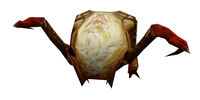
While walking, a Headcrab can be seen lifting its larger claws upward, leaving two of its stubby legs to provide frontal support.
Headcrabs are fairly small creatures, about two feet long from front leg to back and a foot wide. They have round, smooth, flesh-colored bodies and four legs, two long clawed ones on the front and two thick, stubby ones in the back. Despite their small size, the headcrab's back legs can support its entire body, allow it to "tip-toe" across the ground and leap several feet into the air at its prey. Four "mouthparts" can be seen on their front that end in sharp fangs, possibly used to either hang onto a host and/or inject them with a sedative or some other chemical used in the zombification process. Under the body is a round, lipless mouth containing a sharp "beak" used to burrow through the host's skull. (Dr. Kleiner refers to his pet Headcrab Lamarr as having been "debeaked" and thus rendered harmless).
Headcrabs can produce a variety of vocalizations. When they are not hunting, Headcrabs usually emit squeaks and fairly quiet, repetitive calls while gently swaying their bodies back and forth. When attacking, Headcrabs emit a sharp, shrill shriek as they leap towards their victims.
In Half-Life, Headcrabs are found to have originated from a giant creature known as a Gonarch which shares similar physical qualities with Headcrabs. Underdeveloped "baby" Headcrabs spawn at a rapid rate from a sac that dangles beneath the creature. Baby headcrabs look similar to baby scorpions, being very tiny creatures with soft, translucent white bodies.
Behavior and skills
The headcrab can appear harmless at a glance: it is small and slow-moving with its tip toe-like gait. Although it can quickly leap long distances using its hind legs, tilting its body upwards to turn its mouth towards its target, such an assault can only inflict minor injuries with the claws, legs and teeth. However, the Headcrab's main goal is not to kill, but to attach itself onto an appropriate host's head. Using its leaping ability, it can reach a host's head and attempt to burrow its beak through the skull. Once successful, the Headcrab takes control of the host's nervous system and causes physical alterations to the host's body, such as causing its fingers grow into claws, via unknown biological processes. The host then rips open its own torso, revealing the stomach and other organs, for feeding purposes. Such a Headcrab-controlled host is called a Standard Zombie (distinct from zombies created by other Headcrab subspecies, which have different characteristics).
A Headcrab will frequently lie and wait in dark corners or ventilation shafts for unsuspecting prey to walk by. In more open environments, the creatures are known to bury themselves in the ground to hide, then climb out to the surface and attack when a possible host draws near. Headcrabs appear to be fairly unintelligent creatures and will pursue their prey under the most dangerous conditions, moving through dangerous areas or towards hostile prey, even as fellow Headcrabs die in front of them.
Headcrabs have been observed to be prey for Bullsquids, Vortigaunts, and Barnacles, though Lamarr seems to have a taste for watermelons, suggesting that Headcrabs are actually omnivorous, or possibly scavengers when not looking for a host. Headcrabs have also been seen cooked and eaten by humans in Black Mesa East, which suggest that they are used as a common food source after the extinction of most of Earth's species. Citizens in Half-Life 2: Episode One comment that "They don't taste like crab."
It is also apparently possible to "tame" a Headcrab to some extent, as demonstrated by Isaac Kleiner's pet Headcrab, Lamarr.
Tactics
Standard Headcrabs do not pose much of a threat to Gordon on their own. They are easily taken out, and their bite does little damage. However, they can be very irritating in combination with other enemies or in groups. Focusing on the more dangerous enemies, the player might not notice standard Headcrabs leaping at them. In order to avoid those situations, it is preferable to keep moving at all times when Headcrabs are present. Furthermore, a crowbar to the Headcrab's underside while it is leaping will kill it in one swing, and it is fairly simple to hit the Headcrab with Gravity Gun bursts.
The main threat that Headcrabs pose is their numbers. It is common to find many standard Headcrabs, often mixed in with other types of Headcrabs. In a case involving Poison Headcrabs, The Poison Headcrabs should be killed first, as their bite will drain a player's health to 1, leaving them extremely vulnerable. In smaller groups, the Magnum is ideal against Headcrabs, although since its ammunition is scarce, the shotgun can easily replace its role in short to medium ranges. In large groups, or when mixed with other types of Headcrabs, a weapon with a larger clip, such as the SMG, is a better choice. The shotgun is also a formidable weapon against tight groups of Headcrabs due to its spread.
Behind the scenes
- The Headcrab was originally to be used as a weapon in Half-Life 2, mirroring the Snark from Half-Life, as part of the Brickbat weapon. This weapons was to include other props that could be picked up and thrown on enemies by the player (spawning the Molotov cocktail in the playable Half-Life 2 Beta will show Freeman holding a Headcrab, while it appears as a regular Molotov when thrown).
- The Alien Assassin cut from Half-Life 2 was also to have its own zombie version.[2]
- Headcrabs are very similar to Xenomorph facehuggers. Both appear as small creatures that attach themselves to their victims' heads. They also share the same skin color and make similar vocalizations.
Gallery
Pre-release
Retail
List of appearances
- Half-Life: Day One (First appearance)
- Half-Life
- Half-Life: Uplink (Non-canonical appearance)
- Half-Life: Opposing Force
- Half-Life: Blue Shift
- Half-Life: Decay
- Half-Life 2
- Half-Life 2: Raising the Bar
- Half-Life 2: Episode One
- Source Particle Benchmark (Non-canonical appearance)
- Half-Life 2: Episode Two
References
- ↑ Half-Life 2: Raising the Bar
- ↑ Playable Half-Life 2 Beta files
| Creatures | Alien Aircraft • Alien Controller • Alien Grunt • Archer (cut) • Armored Headcrab • Barnacle • Boid • Bullsquid • Charger (cut) • Chumtoad • Fast Headcrab • Fast Walker (cut) • Flocking Floater (cut) • Gargantua• Gonarch • Headcrab • Houndeye • Ichthyosaur • Kingpin (cut) • Leech • Lightning Dog • Mr. Friendly (cut) • Nihilanth • Panther Eye (cut) • Poison Headcrab • Protozoan • Prrobot (cut) • Quiver Creature (cut) • Sand Barnacle (cut) • Snapbug (cut) • Snark • Sphere (cut) • Standard Headcrab • Stukabat (cut) • Tentacle • Unidentified Quiver Creature (cut) • Vortigaunt • Zombie |
|---|---|
| Weapons | Black Hole Gun (cut) • Ceiling Turret • Grenade • Hivehand • Sentry Cannon • Snark • Snark Mine |
| Technology | Healing Shower • Thumper |
| Other | Crystal • Fungus • Healing Pool • Light Stalk • Trampoline • Tree |





